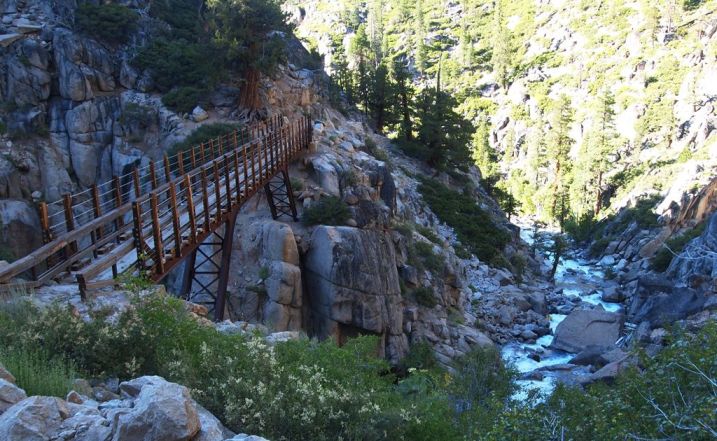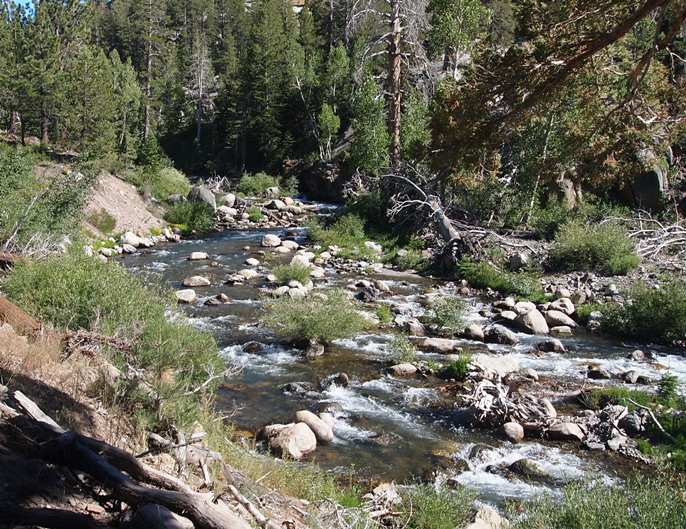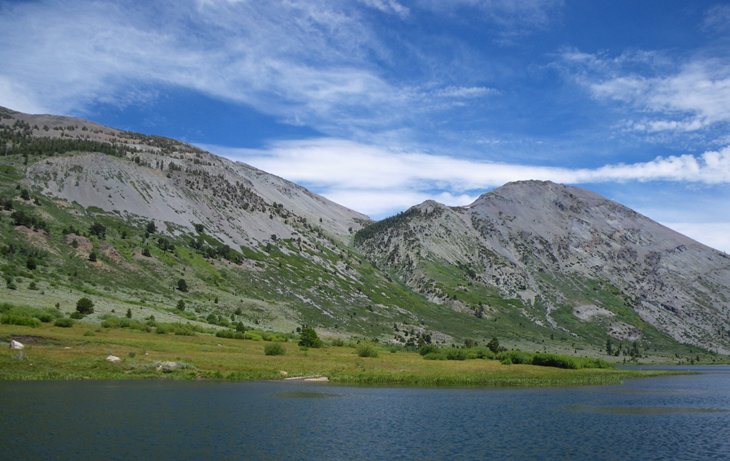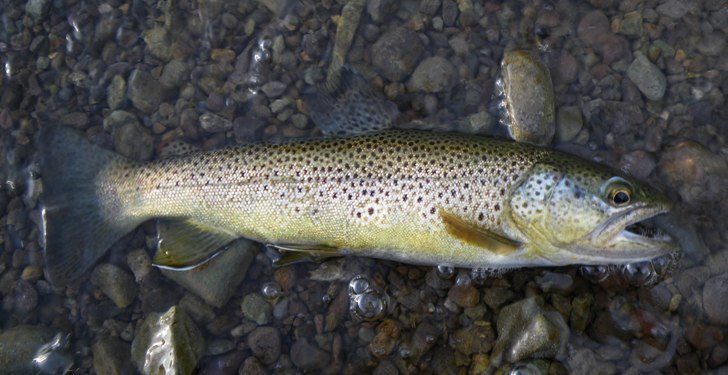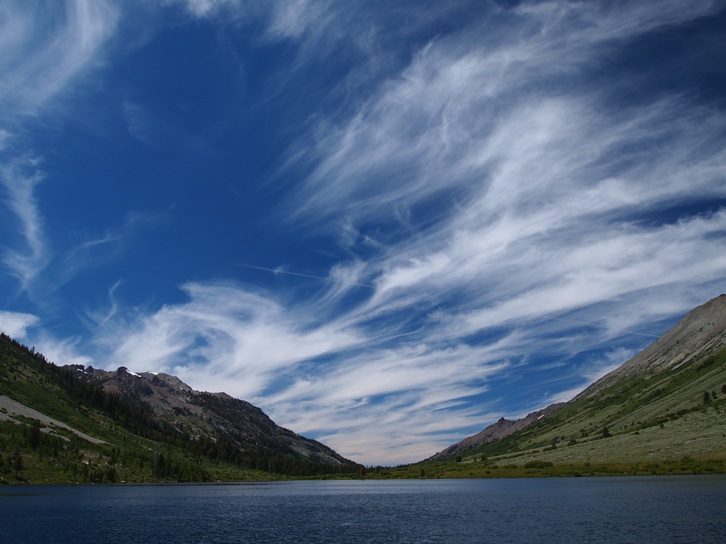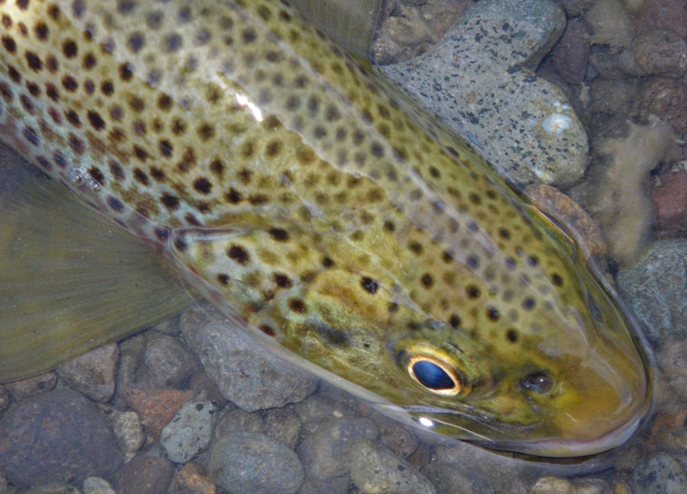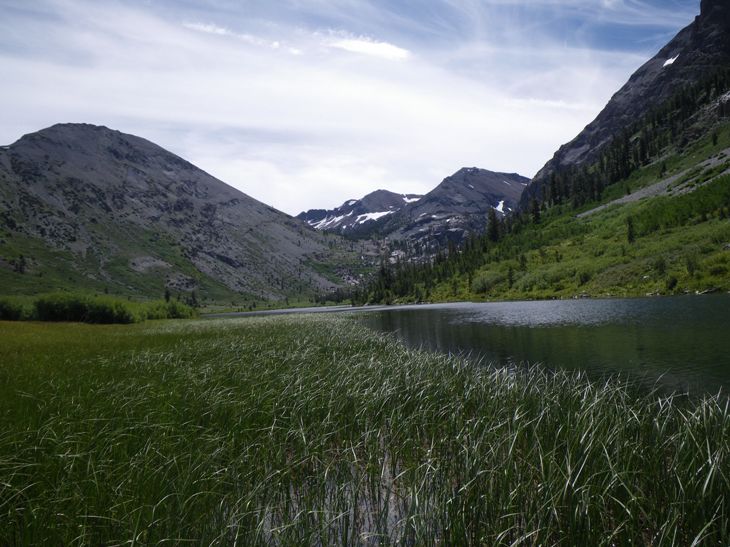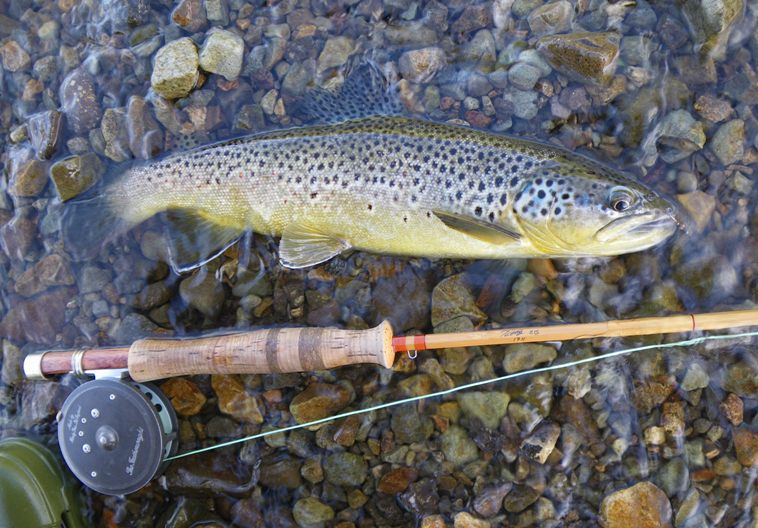|
|
|
|
|
Weather: Cloudy and Mild I'm finding it harder and harder to motivate myself to sleep at the trailhead the night before heading into the high country. The idea of course is to acclimatize to the increased altitude at the trailhead but I find myself wondering these days- "how much can I truly acclimatize in the 4 to 7 hours I'm sleeping at the trailhead?" For altitudes of around 10,000 feet or greater I definitely do feel some acclimatization occurs and is needed but below 8,000, I'm not sure I need it. Here are my thoughts. My body is definitely under increased stress from even one day at altitude. On the Mammoth Lakes trip this year, altitude about 8,000 feet, I did a little experiment. I weighed myself everyday that we were there. I kept up with my normal routine of exercise and made sure to eat normally or actually eat more than normally because we were eating some of our meals at local restaurants. The result, within two days my body weight had dropped 3lbs and by the end of the trip it had dropped 5 lbs. Purely as a result of being at altitude. These conditions were far less stressful than a typical backpacking trip. My point? It seems that any benefit gained by an overnight stay at altitude are balanced by the additional fatigue on the body- so do I stress my body the night before in order to develop a small biological advantage which will enable me to carry more oxygen to an already stressed body or do I arrive at the trailhead with a body rested, full of sea level oxygen and simply allow it to deal the additional stress on the trail? Then, of course, there are the intangibles - am I simply getting lazy in my old age, prefer the comfort of my bed and companionship of my wife over my mummy bag and marmots? Whatever the case, I confirmed with Vita that my second trip out of the Kennedy Meadows trailhead some years ago was undertaken by driving up the morning of and decide to opt for a warm bed over the back of my RAV4. Once again, I credit my desire to fish the Emigrant Wildermess to the writings of Charles McDermand. In Yosemite and Kings Canyon trout he writes about how Kennedy Lake is one of the first high country lakes that can be fished during the season and how he found large trout near the outlet. Unfortunately, this is one case where my experiences didn't mirror those of McDermand. I didn't find overly large fish such as those found in some other Emigrant waters but I did find satisfactory, if not inspiring, fishing for Brown Trout. This surprised me a bit. I didn't do any research on Kennedy Lake before hand. I knew the area from previous hikes departing from the Kennedy Meadows trailhead and had hiked the pass over the valley which holds the lake with Roger last year. This and romantic notions from McDermand of large backcountry fish were all I needed. I naturally expected Rainbow Trout though I'm sure any one of a half dozen or so references in my library would have told me differently. So it was with surprise and elation that I landed my first trout. Kennedy Lake is accessed from the west via Kennedy Meadows or from the east from Leavitt Lake. The western route of about 8 miles is an easy route, with the most difficult portion being the first two miles from Kennedy Meadow to Relief Reservoir. It was at the top of this section that I realized that I wasn't feeling any adverse affects from not spending the night at the trailhead. At least not yet. I felt barely winded as I turned off the main trail to climb the trail Kennedy Lake. The trail begins to back track and continues to go up until it reaches a foot bridge over Kennedy Creek. Kennedy Creek, as with many streams in the Emigrant, looked to be a fine destination in and of itself- a pleasant high country freestone. Once at Kennedy Creek, it is a rolling 5 or so miles to the lake. The trail meanders through a tree filled canyon no more than a stones throw away from the creek at any given time. Once the trail nears the lake several small meadows are thrown into the mix. The largest of which contained grazing cows.
Closer to the lake the meadows and trees are replaced by sage brush. I was surprised to see just how barren the area around the lake actually was and somewhat concerned. I remembered the thunderstorm that Roger and I run from last year and remembered that it went right over Kennedy Peak and into this valley. On the far side of the stream the trees continue up the bank to just shy of the lake and this is apparently where most people camp. I was hoping to camp on the lake proper and far enough away from the pack trains, and the family campers they bring in, as possible. The south bank of the lake was steep and tree lined but not suitable for camping. I could see several small stands of pine trees on the less step north east side of the lake and hoped that they would be suitable for camping. The area immediately around the lake was incredibly marshy. I'm not sure whether this is due to late season run off or springs. The inlet stream is spring feed. I've been to it's source, so it stands to reason that the lake could also have several smaller springs surround it. The small grove of trees was more than suitable for camping. I was relieved I wouldn't have to venture back through the dark, sticky mud in order to camp stream side. The camp site was on a slope but repeated use had flattened out two, maybe 3 distinct tent sites with a high walled fire ring to ensure a warm fire during the afternoon and evening winds. And it was windy. I was the only one on the lake. After setting up camp and eating I set up my fishing line with my new Airflo Clear Floating line and headed to the lake. The near bank was high with trees skirting bank along the water. There were several places where one could climb through and enter the water but casting over the trees would be a problem. The high bank and low trees created an over water perch from which it would hard to adequately stalk and cast to cruising trout. I walked the bank heading east toward the inlet stream looking for cruising trout. The slight ripple on the water made spotting trout difficult. The inlet bank was essentially two small coves or a curved bank with a point- take your pick. It was flat and fairly open. The tree line was about 20 feet from the bank and there was a drop off within casting distance. I pulled enough line off my reel to reach the drop off and made my first cast. The first cast was a tad short so I held a bit more line in the air. These were my first casts with the new line. I had read that the new Airflow lines shot farther than existing lines and was a bit surprised by it's "stickiness". I could actually feel resistance to sliding as I pulled the line through the guides on the haul. It reminded me of issues folks had with the Sylk lines when they were first introduced. On the second cast, with enough line in the air to reach the drop off, the fly hit the water and I immediately started counting down. I imagined my fly's movement in the water. Just as it made the transition over the submerged shelf in my mind's eye, I felt what I thought was a tap. The tug wasn't positive enough to call a take. I could have simply snagged a piece of submerged debris. I wasn't sure. I finished my retrieve and made another cast in the same general area. This time in was sure- tap, tap, tap. I set the hook and found I had a pretty hot fish on the end of my line. I played the fish lightly, not wanting to grant my first fish a long distance release and was surprised to find a brown trout on my line. Other than a vague memory of McDermand catching fish in the outlet, I couldn't remember any details about the lake. I naturally assumed I'd be fishing for rainbow trout since the majority of the lakes I've fished in the Emigrant contain rainbows. The fish fought like a rainbow, complete with aerial display. The brown was about 11 or 12 inches. Healthy in appearance with a light silver hue. I took several pictures and quickly made another cast. Very quickly the scenario repeated itself again and then again and then it suddenly stopped. The wind had started blowing so hard it was forming 12 inch white caps on the surface. I wasn't reaching the drop off and I wasn't catching trout. Fishing can be great in situations like this. The choppy surface creates cover and the fish can feed more freely. Unfortunately, I didn't seem to be getting the right drift. The wind was quickly blowing my line back to shore. I countered this using several British loch techniques but to no avail. My presentation was off. I figured I was either not casting far enough and/or not retrieving slow enough to catch fish. "If I could only get my fly out another 15 or so feet." I thought. Then it hit me. I had my waders with me. I put my waders on and waded out 10 or so feet from shore and continued casting. Occasionally there would be a slight lull in the wind and with my fly in the water and at the proper distance, the lull would slow the fly down enough to allow me a proper presentation and I'd catch a fish or a least get strikes. The takes from these fish were tricky. I found I had to let the fish really commit to the fly before striking. They had to essentially hook themselves or I'd pull the fly away from them. I landed only about 1 fish for every 3 takes. I fished the small cove around to a point and over to the next cove, which held the inlet. The fast current filled a deep hole right off shore. No wading here. I probed the depths here unsuccessfully and had a choice, continue around the lake and fish what appeared to be deep water off a steep bank or go back the way I came and fish toward the outlet. I decided on the latter. I bypassed the tree lined bank. The chop on the water did a good job of obscuring the underwater terrain here and it actually looked as if there was slightly protected area further down the bank. It was slightly protected and the bank was more open. I was still perched a little higher than I would have liked so I waded along the shore and cast to a weed bed that ran nearly the entire length of the lake. I quickly found that a Stillwater nymph cast to the middle of the weed bed and retrieved toward the bank would illicit an immediate response from the fish. In many cases no countdown was needed. My fly would hit the water and be taken as soon as I started my retrieve. It was still difficult to solidly hook the fish and my hook landing ratio continued to be somewhere around 1 fish landed for every 3 takes. There had been cows grazing near the inlet and in late afternoon when they started to mosey their way off the lake, I took that as my cue to head back to camp. The sky had been filled with strange cloud formations; they didn't look like storm clouds but I figured that maybe the cows knew something I didn't. The storms never came and after a quick dinner I was back on the water with rod in hand. The evening was bright and surprisingly warm. The next morning there were several fish rising so I stuffed a pop-tart in my mouth and headed to the small cove near the inlet. My camp site was fairly warm and couldn't have been more than about 100 feet higher than the lake proper but down at the lake it was absolutely frigid. I swapped the clear floating line of the day before for my standard GPX 4wt. This line pairs much better with my rod and I quickly noticed the different. Unfortunately, it was too cold to fish. I quickly went from gloveless, to gloved, to deciding to break camp and wait for the sun to come up a bit. With camp all squared away, I put on my backpack on and I hit the lake. I let the fish dictate where I should fish and kept my pack on so I would not have to backtrack through the boggy shore line to pick it up somewhere. Immediately below my campsite the lake was protected by a wall of brush. While standing in the water the brush was over my head but from the steep bank, I had a pretty good vantage point. I could spot cruising fish while having my silhouette somewhat obscured. The wind was still down and I could easily see fish cursing. Some were even working the surface. I made my way through an opening in brush and waded into position. In the water, it was difficult to see fish much more than a 15 foot cast away but with fish consistently working the surface I decided to focus on them. My initial casts were largely ignored as I tried to match the midges I thought the fish might be taking. When some of the rises start to get a tad splashy, I switched to my cripple caddis fly. From that point on the challenge was spotting the fish and presenting the fly without spooking them. Pretty standard stuff except these fish didn't seem interested in floating flies unless they actually saw them land. Cast within 2 feet of the fish and they'd spook. Much farther than that and they weren't interested. Twitch a long floating fly and it simply seemed to spook them. The fish were more forgiving to sinking flies though and when one fish ignored my floating fly, I made another cast and with a quick tug forced the caddis to sink as the fish approached again. By chance, the timing was impeccable and as the fish approached, the fly sank to exactly the same level. I could clearly see the fly and when the fish opened and closed it's mouth, I set the hook. The fish went bonkers and I landed a nice 13 inches brown. I fished the same general area for several hours before heading to outlet. I'd fished most of this water the day before so I simply walked the bank down to some new water. I was somewhat surprised by all the fish I was pushing off the bank. I made a few casts but not many. I'd worked this water before and all but one fish I spotted were the typical 11 to 13 inches. Of course, the exception probably ran 16 inches. Reeds lined the lake where it narrowed and eventually formed the outlet. It looked like perfect trout habitat. Backpack still on I waded into the reeds to present my fly. Unfortunately, the reeds lay in that dark, mucky type of mud that sucks you into it the more that you move. I made several fan casts along the weed bed but quickly went looking for firmer ground. The reeds looked "reachable" from the other bank so I decided to give that a try later. I found a nice rock close to the bank to drop my pack on and eat some lunch. Looking back toward my previous nights camp I could see that the wind had started to pick up across the lake. Just down the bank from my lunch rock was a small inlet flushing a surprising amount of water into the lake. I fished the seam it created and started picking up fish immediately. At some point I figured out the sweet spot and was inducing takes pretty consistently. I'd started to let the fly sink lower than my standard 15 seconds hoping that, with some current coming into the lake, the bigger fish might be lower in the water column. It paid of and I landed my first and only fish close to 15 inches. I continued fishing down to the outlet stream and crossed over to fish the opposite bank. Given the conditions, I decided that the opposite bank didn't hold many prospects. It seemed too different. I'd been consistently catching fish in shallow water with living vegetation. The terrain here was steeper and appropriately, the lake was deeper. It was also rather barren except for some fallen timber that had rolled down the bank into the lake. It looked like bass water or at least the type of water that would not hold trout until the summer doldrums set it. This is perhaps why the few other fisherman that I did see on my last day kept walking as they searched for good fishing on the south side of the lake. I made my way to where I thought a good roll cast could reach the reeds on the opposite bank. I was right. A good roll cast landed just shy of the weed bed. My soft hackle fly sank about 3 feet and was taken by an 11 inches brown. I landed the fish and hit the trail.
Previous Emigrant Wilderness Chronicle Next John Muir Wilderness Chronicle
|

